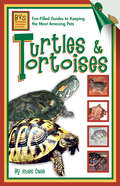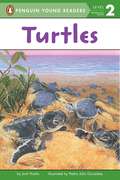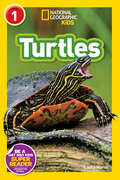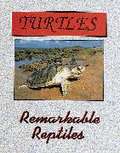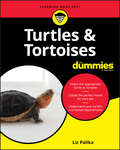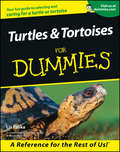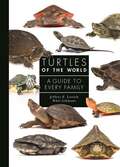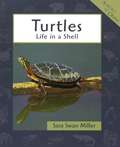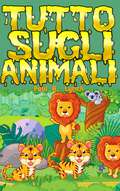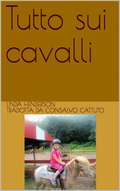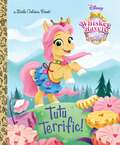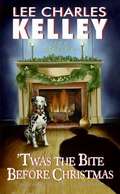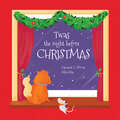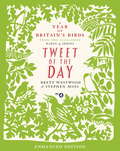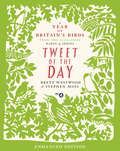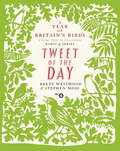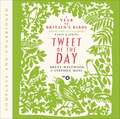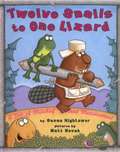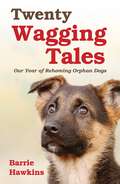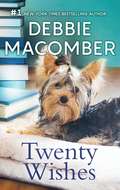- Table View
- List View
Turtles & Tortoises
by Russ CaseIn Turtles & Tortoises beginning hobbyists of all ages will find amazing facts and useful information about turtles and tortoises from around the world. <P><P>Author Russ Case, a noted author and reptile and amphibian specialist, recommends the top twelve turtles and tortoises that are best for first-time keepers, not counting, of course, the familiar box turtle. From the smaller examples, like the mud turtle that grows only 5 inches, to the Galapagos giant tortoise, which can weigh over 700 pounds, Turtles & Tortoises opens up the whole captivating world of chelonians to the reader. This color guide covers the origins of these fascinating creatures as well as the health, feeding, housing, and care of these fascinating creatures.
Turtles (Nature's Children)
by Merebeth SwitzerDescribes the physical features, habits and natural environments for a variety of turtles, tortoises, and terrapins.
Turtles (Penguin Young Readers, Level 2)
by Jodi HuelinDid you know that some turtles can live for 80 years? Or that some turtles are as big as cars? Learn all about turtles in this easy-to-read book.
Turtles (Readers)
by Laura MarshTake a dip with turtles in this exciting reader. Packed with beautiful and engaging photos, kids will learn all about these fantastic reptiles. This level 1 reader is carefully leveled for an early independent reading or read aloud experience, perfect to encourage the scientists and explorers of tomorrow!
Turtles and Tortoises
by James E. GerholdtSnakes, turtles, lizards, and alligators. Frogs, toads, and salamanders. This series examines two often misunderstood animal groups. Readers learn about characteristics, habitats, feeding, and reproduction of these fascinating creatures. -- Supports earth science curriculum-- Detailed text is an excellent resource for reports-- Colorful, close-up photographs of the animals capture and hold readers' attention while enhancing the text
Turtles and Tortoises For Dummies (Dummies Trade Ser.)
by Liz PalikaSelect the appropriate turtle or tortoise Create the perfect home for your pet Understand your turtle's nutritional requirements Discover how to care for your pet turtle This fun guide will help you choose the perfect turtle or tortoise for your lifestyle and give it the care it needs to thrive. Turtle and tortoise expert Liz Palika provides clear, step-by-step instructions on how to set up a tank, maintain proper water conditions, and feed and care for your chelonian. With descriptions of over 80 species of turtles and tortoises and information on everything from heat lamps to photoperiods, you'll find all you need to keep your reptilian companion safe and happy throughout its life. Inside... Provide a suitable environment Care for a variety of species Supply a satisfying and healthy diet Maintain your pet's health Breed your turtle or tortoise Learn more with helpful top ten lists
Turtles and Tortoises For Dummies (Dummies Trade Ser.)
by Liz PalikaCoexisting with a turtle or tortoise may not be a warm and fuzzy experience, but it definitely has its rewards. And with more than 250 species to choose from, you’re bound to find one that’s right for you. Looks-wise, they can range from very plain and unadorned to a brightly colored and embellished with every manner of crest, crown, spike, and dewlap. As for personality, you’d be amazed at how very different they can be, ranging from shy and withdrawn, to outgoing and friendly, to outright aggressive. And when it comes to longevity, well, let’s just say that when you commit to a turtle or tortoise, you’re in it for the long haul. For example, the standard American box turtle can live more than 125 years, a leopard tortoise has a life span of up to 100 years, and an aldabran tortoise can live to be more than 200 years old! This fun guide will help you choose the perfect turtle or tortoise for your lifestyle and give it the care it needs to thrive. Turtle and tortoise expert Liz Palika provides cl ear, step-by-step instructions on how to: Select the appropriate turtle or tortoise Provide a suitable environment for your new pal Care for a variety of chelonian (turtle and tortoise) species Supply you pet with a satisfying and healthy diet Create an indoor or outdoor home Understand your turtle’s or tortoise’s special needs Generously illustrated with line drawings and high-quality photographs, Turtles & Tortoises For Dummies covers all the bases. Topics covered include: Deciding whether a turtle or tortoise is right for you Choosing between a turtle and tortoise Who’s Who of turtles and tortoises—a complete guide to dozens of species, where they’re from, what they’re like, and how they are as pets Creating a safe and healthy environment for your pet Recognizing and treating common health problems and finding a good veterinarian to help you care for your chelonian Turtles & Tortoises For Dummies is your fun guide to selecting, caring for, and sharing your life with a chelonian.
Turtles of the World: A Guide to Every Family
by Whit Gibbons Jeffrey E. LovichA lavishly illustrated guide to the world's turtles that covers every family and genusTurtles of the World reveals the extraordinary diversity of these amazing reptiles. Characterized by the bony shell that acts as a shield to protect the softer body within, turtles are survivors from the time of the dinosaurs and are even more ancient in evolutionary terms than snakes and crocodilians. Of more than 350 species known today, some are highly endangered. In this beautiful guide, turtle families, subfamilies, and genera are illustrated with hundreds of color photographs. Each genus profile includes a population distribution map, a table of information, and commentary that includes notable characteristics and discussion of related species.More than 250 beautiful color photosEach profile features a distribution map, table of information, and commentaryBroad coverage includes every family and genus
Turtles: Life In a Shell
by Sara Swan MillerAn introduction to turtles that includes descriptions of fifteen species and recommendations for finding, identifying, and observing them.
Tutto sugli animali
by Paul A. LynchGli animali sono ovunque sulla terra. Questo significa che se dovessimo viaggiare in ogni paese e continente troveremmo un animale che ci vive. Alcuni animali vivono in un clima caldo e altri in un clima freddo. Gli animali esistono da secoli. Alcuni animali come lucertole, tartarughe e pesci sono in giro da più tempo dei dinosauri. Leggete questo breve libro di saggistica e imparate tutto quello che potete sui nostri animali più amati.
Tutto sui cavalli
by Linda HendersonQuesto libro è scritto per i bambini che amano i cavalli e vorrebbero imparare il più possibile su di loro. Descrive fatti interessanti sulle molteplici razze di cavalli, dove si trovano, cosa amano mangiare, ecc. Ci saranno cavalli in paradiso? Le risposte si trovano in "Tutto sui cavalli". Se ami i cavalli non potrai perderti questo libro!
Tutu Terrific! (Little Golden Book)
by RH DisneyThe Disney Palace Pets are getting ready to march in the Tutu Terrific Parade! This Little Golden Book, featuring an all-new Whisker Haven Tales story, will delight children ages 2 to 5!
Twas the Bite Before Christmas (Jack and Jamie Mystery #4)
by Lee Charles KelleyThe maid for a wealthy couple who lives in a mansion along the Maine coast, is found dead at the bottom of the main staircase a few weeks before Christmas. The couple claims that the maid's ex-boyfriend ran out of the house just as they arrived home, but there are no footprints in the snow, and the guard at the front gate didn't see anyone leaving the property. Jack and his fiancÉe, local medical examiner Dr. Jamie Cutter, reluctantly leave their eggnog and tinsel when they are called in to help catch the killer. Soon Jack realizes that there is more at work than simply murder: a mysterious visitor has been conning the rich couple with tales of spirits, magic, and elfin visitors. 'Tis the season for tracking down the truth, so Jamie and Jack set out for New York City and end up in a foot chase that takes them through the snow-covered city, tailing a lost Dalmation puppy, mysterious elves, a sly killer, and the true meaning of Christmas.
Twas the Night Before Christmas: Edited By Santa Claus For The Benefit Of Children Of The 21st Century (Xist Children's Books)
by Clement C. Moore Sofia SitaThe creatures are stirring in this perennial holiday favorite as they wait for Santa Clause to arrive. An animal-centric take on the classic. Clement C. Moore&’s original poem, &“A Visit from St. Nicholas,&” has been brought to lovable life by the talented Sofia Sita. In this edition, the beloved poem is joined with delightful illustrations imagining the visit from the house&’s animals&’ perspectives. Children will be delighted to snuggle in for story time on Christmas Eve and wait for their own visit from Santa Claus after reading this book.
Tweet of the Day: A Year of Britain's Birds from the Acclaimed Radio 4 Series
by Stephen Moss Brett WestwoodImagine a jazz musician, improvising on a theme. Then imagine that he is able to play half a dozen instruments - not one after another, but almost simultaneously, switching effortlessly between instruments and musical styles with hardly a pause for breath. If you can countenance that, you are halfway towards appreciating the extraordinary song of the nightingale . . .Wherever we are, there are birds. And wherever there are birds, there is birdsong. It's always a pleasure (and a relief) to hear sounds which prove the world's still spinning: whether it's the sighing of migrating redwings on a damp October night, the twitter of swallows fresh in from South Africa in April or the call of the cuckoo in May. Based on the scripts of BBC Radio 4's beloved year-long series, and distilling two lifetimes' knowledge, insight and enthusiasm into these pages, Brett Westwood and Stephen Moss take you month by month through the year, and the changing lives of our favourite birds. From peregrines swapping sea-cliffs for skyscrapers to swifts spending almost their entire lives on the wing; from charms of goldfinches to murmurations of starlings; from ptarmigans thriving in the Highland snow to the bright green parakeets thronging London's parks; this book is packed full of extraordinary insights and memorable facts. Tweet of the Day is a book for everyone who loves Britain's birds.(Illustrations © Carry Akroyd)
Tweet of the Day: A Year of Britain's Birds from the Acclaimed Radio 4 Series
by Stephen Moss Brett WestwoodImagine a jazz musician, improvising on a theme. Then imagine that he is able to play half a dozen instruments - not one after another, but almost simultaneously, switching effortlessly between instruments and musical styles with hardly a pause for breath. If you can countenance that, you are halfway towards appreciating the extraordinary song of the nightingale . . .Wherever we are, there are birds. And wherever there are birds, there is birdsong. It's always a pleasure (and a relief) to hear sounds which prove the world's still spinning: whether it's the sighing of migrating redwings on a damp October night, the twitter of swallows fresh in from South Africa in April or the call of the cuckoo in May. Based on the scripts of BBC Radio 4's beloved year-long series, and distilling two lifetimes' knowledge, insight and enthusiasm into these pages, Brett Westwood and Stephen Moss take you month by month through the year, and the changing lives of our favourite birds. From peregrines swapping sea-cliffs for skyscrapers to swifts spending almost their entire lives on the wing; from charms of goldfinches to murmurations of starlings; from ptarmigans thriving in the Highland snow to the bright green parakeets thronging London's parks; this book is packed full of extraordinary insights and memorable facts. Tweet of the Day is a book for everyone who loves Britain's birds.(Illustrations © Carry Akroyd)
Tweet of the Day: A Year of Britain's Birds from the Acclaimed Radio 4 Series
by Stephen Moss Brett WestwoodImagine a jazz musician, improvising on a theme. Then imagine that he is able to play half a dozen instruments - not one after another, but almost simultaneously, switching effortlessly between instruments and musical styles with hardly a pause for breath. If you can countenance that, you are halfway towards appreciating the extraordinary song of the nightingale . . .Wherever we are, there are birds. And wherever there are birds, there is birdsong. It's always a pleasure (and a relief) to hear sounds which prove the world's still spinning: whether it's the sighing of migrating redwings on a damp October night, the twitter of swallows fresh in from South Africa in April or the call of the cuckoo in May. Based on the scripts of BBC Radio 4's beloved year-long series, and distilling two lifetimes' knowledge, insight and enthusiasm into these pages, Brett Westwood and Stephen Moss take you month by month through the year, and the changing lives of our favourite birds. From peregrines swapping sea-cliffs for skyscrapers to swifts spending almost their entire lives on the wing; from charms of goldfinches to murmurations of starlings; from ptarmigans thriving in the Highland snow to the bright green parakeets thronging London's parks; this book is packed full of extraordinary insights and memorable facts. Tweet of the Day is a book for everyone who loves Britain's birds.(Illustrations © Carry Akroyd)
Tweet of the Day: A Year of Britain's Birds from the Acclaimed Radio 4 Series
by Stephen Moss Brett WestwoodImagine a jazz musician, improvising on a theme. Then imagine that he is able to play half a dozen instruments - not one after another, but almost simultaneously, switching effortlessly between instruments and musical styles with hardly a pause for breath. If you can countenance that, you are halfway towards appreciating the extraordinary song of the nightingale . . .Wherever we are, there are birds. And wherever there are birds, there is birdsong. It's always a pleasure (and a relief) to hear sounds which prove the world's still spinning: whether it's the sighing of migrating redwings on a damp October night, the twitter of swallows fresh in from South Africa in April or the call of the cuckoo in May. Based on the scripts of BBC Radio 4's beloved year-long series, and distilling two lifetimes' knowledge, insight and enthusiasm into these pages, Brett Westwood and Stephen Moss take you month by month through the year, and the changing lives of our favourite birds. From peregrines swapping sea-cliffs for skyscrapers to swifts spending almost their entire lives on the wing; from charms of goldfinches to murmurations of starlings; from ptarmigans thriving in the Highland snow to the bright green parakeets thronging London's parks; this book is packed full of extraordinary insights and memorable facts. Tweet of the Day is a book for everyone who loves Britain's birds.(Illustrations © Carry Akroyd)
Tweet of the Day: A Year of Britain's Birds from the Acclaimed Radio 4 Series
by Stephen Moss Brett WestwoodImagine a jazz musician, improvising on a theme. Then imagine that he is able to play half a dozen instruments - not one after another, but almost simultaneously, switching effortlessly between instruments and musical styles with hardly a pause for breath. If you can countenance that, you are halfway towards appreciating the extraordinary song of the nightingale . . .Wherever we are, there are birds. And wherever there are birds, there is birdsong. It's always a pleasure (and a relief) to hear sounds which prove the world's still spinning: whether it's the sighing of migrating redwings on a damp October night, the twitter of swallows fresh in from South Africa in April or the call of the cuckoo in May. Based on the scripts of BBC Radio 4's beloved year-long series, and distilling two lifetimes' knowledge, insight and enthusiasm into this recording, Brett Westwood and Stephen Moss take you month by month through the year, and the changing lives of our favourite birds. From peregrines swapping sea-cliffs for skyscrapers to swifts spending almost their entire lives on the wing; from charms of goldfinches to murmurations of starlings; from ptarmigans thriving in the Highland snow to the bright green parakeets thronging London's parks; this audiobook is packed full of extraordinary insights and memorable facts.Tweet of the Day is a book for everyone who loves Britain's birds, and this audiobook contains over 150 birdsong recordings to bring them to life.(P)2014 John Murray Press
Tweety Plays Catch the Puddy Tat
by Eileen DalyTweety tries to think of a way of getting Sylvester to stop chasing after him, at least for a little while.
Twelve Snails to One Lizard A Tale of Mischief and Measurement: A Tale Of Mischief And Measurement
by Susan HightowerMilo the beaver wants to repair a dam which has developed a breach. Bubba the bull-frog gives him ideas about how to get the right measurement of the logs.
Twenty Gallant Horses: Illustrated Stories of the Great Turf Champions of All Time
by C. W. AndersonThis easy to read book shares the stories of twenty of America's famous racehorses. Horses like Heatherbloom, able to jump eight foot fences, Snow Man, who won the triple crown of jumping, Seabiscuit, and War Admiral, two of the most famous race horses are included.
Twenty Wagging Tales: Our Year of Rehoming Orphaned Dogs
by Barrie HawkinsAfter losing his beloved dog, Elsa, Barry can't face replacing her. When he accepts a rescue worker's proposal to become a dog foster parent he doesn’t realise what he is letting himself in for. This heart-warming collection of true furry tales follows the highs and lows of Barrie and his wife as they take on the challenge of rescuing dogs.
Twenty Wagging Tales: Our Year of Rehoming Orphaned Dogs
by Barrie HawkinsAfter losing his beloved dog, Elsa, Barry can't face replacing her. When he accepts a rescue worker's proposal to become a dog foster parent he doesn’t realise what he is letting himself in for. This heart-warming collection of true furry tales follows the highs and lows of Barrie and his wife as they take on the challenge of rescuing dogs.
Twenty Wishes (A Blossom Street Novel #5)
by Debbie MacomberCome back to Blossom Street! Join #1 New York Times bestselling author Debbie Macomber for this hopeful story of enduring friendship and starting over.What do you want most in the world? What Anne Marie Roche wants is to find happiness again. At thirty-eight, she’s childless, a recent widow. She owns a successful bookstore on Seattle’s Blossom Street, but despite her accomplishments, there’s a feeling of emptiness. On Valentine’s Day, Anne Marie and several other widows get together to celebrate…a sense of hope. They each begin a list of twenty wishes—including things they’d always wanted to do but never did. Some of the items on Anne Marie’s list: learning to knit, falling in love again, doing good for someone else. When she volunteers at a local school, an eight-year-old girl named Ellen enters her life. It’s a relationship that becomes far more involving—and far more important—than Anne Marie had ever imagined. As Ellen helps Anne Marie complete her list, they both learn that wishes can come true…but not necessarily in the way you expect!Originally published in 2008
